Books
Compiled by Martin Willey
Anderson Entertainment, UK, 17 December 2021, £34.99
272 pages, hardcover, 300 x 230 x 25 mm
ISBN 978 19145 2215 4
Written and illustrated by Chris Thompson
Sections 7 ("Command Roster", character profiles) and 8 ("Alien Technology", episode summaries) written by Andrew Clements
Additional contributors Phil Plait ("Breakaway event", p108-110) and David Parker ("Eagle Propulsion", p1380-139)
Moonbase Alpha (p17) illustrated by Keith Young (also credited as Paxton Yong on p272)
Uniform illustrations (p208-210) by Christina Logan
Alpha Poster (p10) by Katie O'Kane
Initial sales from the Gerry Anderson online store for the week of 13 September 2021 include an A4 art print "Conquer the Moon" by Katie O'Kane (as featured on page 10) and an iron-on cloth patch (120mm wide).
Some of the information and images also appear in the Space: 1999 Role Playing Game (2025).
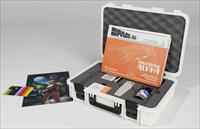
The special edition was limited to 311 copies. It comes in a case, with travel tube map, ID card, radiation detector and anti-radiation pills (mints) and a letter from the desk of Commissioner Simmonds. The price from 13 September 2021-19 September is £149, afterwards £199. The design of the case and radiation detector (a real EMF detector, used for detecting wiring problems) are not accurate to anything in the series. More
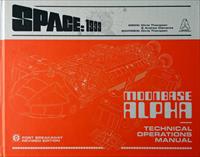
This book is presented as an updated version of the Starlog Technical Notebook, complete with original author David Hirsch doing an (in-universe) foreword on page 6. But in style it is much closer to the Haynes "Owners' Workshop Manual" series, which traditionally did UK car maintenance manuals and since 2010 have done science fiction subjects including Star Trek, Star Wars and Thunderbirds. The cover, with orange background and isometric line drawing, is the Haynes style. The interior follows the Haynes Trek and Star Wars mix of text, photos, isometric computer drawings and orthogonal plans.
Two alternative approaches would have been the Graham Bleathman cutaway art (he did the Haynes Thunderbirds book, plus numerous other publishers), and the Nick Foreman/Chris Bentley UFO Technical Manual, which was more heavily based on the computer art. There aren't any cut-aways in this book, sadly.
It includes around 250 computer illustrations by Chris Thompson, including isometric room plans, digital art of Alpha technology and blueprints, as well as numerous series photos. Additional writers include David Hirsch (who wrote the original Technical Notebook for Starlog, and does the foreword here), and science writers Phil Plait and Dr David Parker. Additional artists include Paxton Young (who did the Keith Young fan blueprints).
The text is an "in-universe" description, with post-breakaway addenda (very similar to my own Operations Guide, originally written in the 1980s). It concentrates on Earth technology, with only chapter 8 (pages 252-267) covering "alien technology" (text and photos describing selected episodes, with the only art illustration being the line-drawing of Gwent on the chapter spread).
The book covers most of the familiar rooms, props and vehicles seen in the series. Overall the art is very well done. It is not comprehensive, but most of what a fan would expect is here. The last section is missing many aliens, planets and spaceships. It is very visually based, while the text is often basic and rarely elaborates on the history or the science.
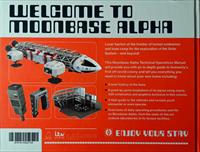
The back cover: "Welcome to Moonbase Alpha". One slight problem is the rescue Eagle with too thin red stripes.
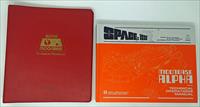
The original 1977 Technical Notebook alongside the 2021 Technical Operations Manual. The Technical Notebook was in a 3-ring loose-leaf binder with single-sided pages. The Technical Operations Manual is full colour throughout.
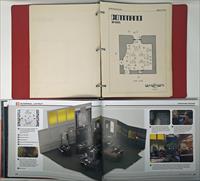
The isometric room layouts are clear and dramatic, and the captions and side-bars highlight aspects of the sets. The main disadvantage of the bound book is the gutter between two pages when images are spread over both, whereas the Technical Notebook had fold-out pages.

The naming "Comms Post", used in one episode, is odd. Thanks to high definition prints, we know the black panel near the bottom of the communications post has radial dials. Neither book knows what to do with this; it is either the computer memory core (RAM? HDD? CPU?), or "electronics and maintenance access panel". An obvious point that could have been made is that communications posts are cellular base stations, relaying communications and computer services between commlocks and central networks in a radio-shielded moonbase.
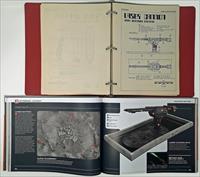
The laser cannon or laser battery. Both books point out the heat dissipation panels. The Technical Operations Manual has some nice additional background in the side-bar, explaining how the technology was salvaged from the wrecks of alien ships which we saw in year 1.

Spacesuits. The Technical Operations Manual has additional pages with close-ups of the chest pack and back pack (the ugly Space Warp version with dial), helmet and EVA jet pack.

The stun guns. The Technical Notebook got the nozzles wrong. The Technical Operations Manual is missing details around the nozzles in the side plan, although they look correct on the render on the previous page. The Technical Notebook has a better description of "model 1" and "model 2" stun guns (the latter with stun/kill slider). Otherwise the Technical Operations Manual reuses the same descriptions and even specification numbers of the Technical Notebook.





Chapter 1 is mostly full page art showing the early Moonbase, Keith Young's Moonbase plan, and the setting in Plato crater. This section uses Hirsch's original history from the 1977 Technical Notebook with additional material (the first moonbase commander is Franco Desica, a character cut from Gerry Anderson's series UFO). Otherwise there is no mention of the UFO scenario, or the 1987 world war (there are some more mentions later on, but it is fragmentary). Following Hirsch, and original ITC publicity, the base is located in crater Plato. This website has detailed discussion why in-series references and science suggest better locations.



The isometric room layouts are nicely done, covering the main sets plus a few speculative locations (stairs, bathroom, main dining area, customs area based on an early Keith Wilson design). The isometric views show us 2 of the 4 walls, and give a good impression of the layout. The main problem is they are very dark. Some of this may be because the drawings show so much dark flooring. On screen the sets are normally pale and flooded with light (in some episodes they did use moody shadows, but that was not the normal aesthetic). Some of the floors, especially Koenig's office, have very dark brown floors. They seem to be coloured based on the pieces of brown carpet that are sometimes used for sound-proofing, but they weren't supposed to be seen on screen.
The main sets like Main Mission and Command Center had layout changes through the series, and inconsistencies, some of which the book mentions (the side steps in Main Mission can be removed to add further consoles; the conference table in Koenig's office is "collapsible"). It would have been nice to have included smaller renders of alternative layouts (Main Mission without the side steps and with later desk layout including Kano's desk; Command Office with conference table). It would also be useful to show the other 2 walls. There are small issues with the dimensions of some of the furniture (for instance, the beds for the living quarters look wrong).
The text doesn't address some inconsistencies, like the travel tube interior versus exterior, although it does say there are smaller travel cars in less busy areas. The travel tube system is described as a scheduled circulation system, like a city metro, not on-demand automated transit, which it seems to be. A photo of Medical with a prominent window (from War Games, p45) is shown alongside a caption about Secure Bunkers, which is definitely isn't. The communications post is called "comms post" here (p46), a term never used in the series (production documents use the term "compost" which is even less ideal).
The Medical Center on p51 is a variation of the Year 2 version 4 and version 5; there is no depiction of variations and numerous Year 1 versions of Medical Centers. It would have been nice to see a year 1-type medical centre with isolation or operating room, as featured in many episodes. The "bio watches" mentioned on page 50 is the only mention of what the series called wrist monitors and were worn fastidiously in year 1. The year 1 design was different to the Journey To Where design shown. This probably should have been featured in the Uniforms and Equipment section, because it was a small but important plot point in several episodes.
There are 3 technical labs out of many possible (6b from Last Sunset, Techlab 5 from Beta Cloud and the Research cave). The Life Support on p62-63 is the Beta Cloud variation. The only leisure room is the Force of Life solarium on p72-73, plus the conjectural dining area.
There are several pages devoted to the Eagle hangars (from p76) and launch pad. I'm not sure of the naming of the "foundry", which seems to be an assembly area for Eagles, rather than a furnace and metal casting which the title implies.
The invented customs area, based on Keith Wilson's voice print designs, is good looking but logically dubious, as is the description of UV decontamination. The description of the catacombs mentions both titanium and dilinite; in the series they contain tiranium and dylenide crystals, and titanium is only found on alien planets like Pyschon. The catacombs are man-made mines here, although empty lava tubes exist on the Moon and would be ideal locations for a real moonbase. There is a side-bar about "long forgotten military installations" and painting of Shado Interceptors from UFO. The Weapons Section includes an armoury side-room, and the view obscures much of the control panel.
The computer room description mentions a massive mainframe. For all the primitive I/O computing (print-outs/punch cards and lack of screens), there is a lot of interesting computing which is not discussed, such as the modular component-based design which is fundamental to modern data centers.
The nuclear waste chapter shows a nuclear transport ship and mentions the 1987 war and a Dalotek moonbase (from UFO). The text here is a little lightweight; there is more to discuss about different aspects of the facilities.
This short chapter concludes with Phil Plait's discussion of the breakaway, with a nice reference to the "magnetically unconstrained flux" or MUF.



One obvious problem on these Eagle pages is the rescue Eagle, which has very thin red stripes (this is also shown on the back cover).
There is a small picture of the Falcon, which is based on the Chris Foss pre-production design with orange command module, and two "early" versions of the Eagle, before the familiar Eagle, here the "mark III". Mostly the Eagle shown is based on the first 44 inch Eagle, but occasionally the second 44 inch is shown. The Eagle has a set of plan views, with some obvious captions and some curious ones- I don't know what a "primary dorsal harpoint" is. There is nice art of the Eagle during re-entry with retracted leg pads (performing a retrograde engine burn, although the text credits "gravity shielding" and mentions ablative shielding).
Interior sets include a very nice front-view of the command module. In addition to the 6 familiar pods, there are two additions, a round habitation module and a vehicle transport cage. There are only 3 interiors- the standard pod (with computer side wall), and hypothetical rescue and lab pods. Again, there are several on-screen variations without computer side wall that would have been nice to see. The lab pod is an attempt to map some of the interior walls from All That Glisters to the exterior shape of the lab pod. There is no reference to how an Eagle can carry a moonbuggy, and the boarding tube is quickly described in text as collapsible.
Armament shows the laser turret, and the invented command module laser. There is passing reference to a "Straker doctrine", referencing the lead character from UFO. There is no mention of the protective force fields featured in some episodes, or conventional missiles (mentioned in one episode, and implied by the slower-than-light light beams). There are renders of the grab arm, boosters and mine grab, but a notable omission is the Space Brain grab. The invented addition here is an AWACS-type sensor dome.
David Parker's one-page summary of the Eagle engines (p139) drops some authentic-sounding jargon, including the main engines being tokomak magnetic bottles.
A short section of emergency procedures (command module separation, ejection, remote control), introduces "internal plasti-shields" to sub-divide the passenger module.



This section is dedicated to the "guest" ships of Earth origin. It is the longest chapter, although each craft occupies between 2 and 6 pages. There are plans for each of the craft, as well as renders. Apart from the "Talon Interceptor", everything is from the series, with one obvious missing ship - the Uranus Probe/Phoenix from Death's Other Dominion. Ships that are mentioned but not seen in the show (like Lee Russell's Astro 7) are not shown or mentioned here. The book mentions voyages to Mars, Venus and Io, but the ships are not shown.
There is a nice size diagram showing all the ships to scale, but the order of vehicles in this chapter is confusing, starting with the massive Space Dock, then immediately next is the moonbuggy, and then we continue to skip through large interplanetary probes to small ferries and back again. There is no obvious size, class or historical order here. At least a time-line of ships is really needed here.
We also need an explanation for how space travel has become so advanced. Star Trek had warp engines and later inertial dampers, which are imaginary, but they address the science laws being broken. Space: 1999 has the Queller Drive, Bergman's gravity generators/forcefield and some alien hyperspace and jump drives. Apart from some fragmentary references plus a little bit about exotic matter and "energy density" in the Superswift section, this book doesn't develop the ideas. My own inventions were based on graviphotons (real but hypothetical particles from theoretical physics) to create anti-gravity, and a matter state that formed an envelope around a ship, or the Moon, allowing us to temporarily ignore rules of mass and energy conservation. Which is as imaginary as a warp drive, but acknowledges real world physics. Even magic has rules, and I would expect a technical manual to outline some rules.
The Space Dock is described as being in "geosynchronous orbit above the Moon", which is nonsense (it's either a selenocentric orbit, or halo orbits or Lissajous orbits around a Lagrangian point). It's called the Centuri space station (after Hirsch and the model rocket company) and later there's a reference to "Centari-class stations" (probably a typo for Centauri). There are references to a Hermes station around Mars and Aphrodite station around Venus.
Another reference to UFO is the moonmobile photo on p151.
The "Eagle nose" laser tank is called an ATEV here- all terrain exploration vehicle. This is implicitly linked to Sanderson's surface exploration group. The vehicle is also shown with a radar dish replacing the laser gun. An odd caption describes this as the "dorsal harpoint", which also appeared on the Eagle plans. This may be invented jargon, or perhaps a "harpoint" (repeated twice in the text) is a typo for "hardpoint", a technical name for a weapons attachment point on an aircraft. The two other laser tank designs are called "laser tractor", with flat-top and "heavy" versions.
The Superswift pilot ship is called the Moon Hopper here. The Hawk description mentions the "Eastern Bloc" leading to the 1987 war, which seems to be a nod to Blam comic Aftershock from 2012. There's 4 nice pages devoted to the Hawk, including a nice but dark cockpit layout. The book misses the opportunity to show launching/landing and boarding procedures, which would be fun to invent. Similarly, the Ultra Probe and Swift only has photos of the interiors, when interior layouts would have been nice to see.
The text says the Swifts operate in groups, with one designated as the mothership, so there is no separate mothership design. The Superswift design is given its own 6 page section, with a description of a Star Trek-like warp drive, which isn't really supported by the episode. The Queller Drive is explained as being a fusion drive using Xenon 135 to produce neutrons, which is odd (Xenon 135 is a fission product of uranium, and is a powerful neutron absorber, contributing to the poisoning of the Chernobyl reactor). Here the Voyager 2 disaster happens during a gravity assist around Mars "wiping out several settlements".
The final 4 pages are devoted to an invented craft, the Talon Interceptor, which is a small fighter ship developed after breakaway.



The uniforms section is quite brief. The year 2 jackets are colour-coded, according to this. The "patches and logos" covers the insignia, largely following the Mare Fitzgerald descriptions from 1979. There are renders of the spacesuit helmet, chest pack, back pack and EVA "jetpack".
The book uses a single "m" spelling of "comlock". This is debatable, but most series documents use the two "m" spelling of "commlock". There's some shots of the screen menus, looking like 1990s smartphone screens, which is a nice idea, although the font is slightly wrong.
The stun gun and all three types of laser rifle are shown, with plans. There's some nice additional props here, including Helena's Alpha log recorder and the sensor unit with adjustable arm. There's a lot more that could be done, which could fill a book on their own: mobile nuclear generator, Eagle remote control, translation calculators, organitron, water analyser...

While the chapter concentrates on the commlock and weapons, it was good to see some of the less-featured props, although there are just renders, no plans.

The shortest chapter, with profiles of Koenig and the other regulars, closely based on Hirsch's original profiles (birth dates and assigned dates are copied over). Like Hirsch, additional characters like Yasko and Ben Vincent are ignored. Bergman is killed off on the lunar surface in a "meteor storm" (science oops!), Paul Morrow is in a year long coma after being in an Eagle explosion, and there is no explanation for Kano disappearing.

There's no more art here, it's one page episode summaries, written as reports by "Professor Bergman" or "Maya", with episode photos. They don't cover all alien technology or planets. Only 12 episodes are covered, and numerous episodes are missing. The brief summaries are somewhat superficial. There's nothing about Last Enemy, for instance, which left two big spaceship wrecks near Alpha which, as the text notes elsewhere, were cannibalised for Alpha's defence (as seen in The Dorcons). There is scope for a lot of fun speculation here, as well as loads of alien ships to show.
Strangely for an operations manual, this is the only operational procedure in the book. The phases don't correspond to any of the (inconsistent) Operation Exodus phases described in the series. Oddly there is nothing on organisation, apart from listing the sections (just the colours, not the roles) and a reference to the shift rotas (with no explanation of them). The catacombs version notes all the inconsistencies, but a brief, logical summary of that would satisfy the gap here.
This is an ambitious and impressive book. Visually it's spectacular. The digital art is very well done, and it is nice to see the plans for ships and some props too. The only significant problem is the darkness of the isometric room layouts. The book is not really comprehensive, but it has very good coverage of most the familiar sets, props and ships. In many cases I would like to have seen a little more for each subject- things like room variations, or Hawk launching apparatus.
The alien encounters, and personnel profiles, feel a bit like filler. It would have been nice to drop this, and expand some of the earlier pages. If there is a second volume, the alien encounters could be expanded and could be really good fun.
The text and photo captions are mostly good, but generally lightweight. I liked David Parker's Eagle propulsion notes, but it would have been nice to have some science scrubbing of much of the rest of the text too, plus some consistent imaginary "magic/science" to give it all some sense. It is a significant constraint that all the text has to be "in-universe", particularly as, like any other show, Space: 1999 was not very consistent or logical. It is possible to add a bit more depth and realism to the show, as we've done that throughout this site (the Operations Guide, the continuity guide).
The book is missing some explanation of the history of space travel, and of the technology. It doesn't have to be elaborate and detailed; it needs some more scene setting, not world building. There are passing references to UFO, and the 1987 world war (from Rules of Luton) is also mentioned, but there is not enough context. Why were the Hawks developed, why are their stun guns and laser rifles on the moonbase? It is not hard to invent a credible history for this, but there are no answers here. The Hirsch technical notebook had a time-line section which did add some context, but there is no equivalent in this book.
These criticisms are nit-picking, and perhaps unrealistic in times of cost and effort for a commercial book, but it is a (minor) missed opportunity. Overall, it is very well done, and a handsome addition to the bookshelf.
Copyright Martin Willey